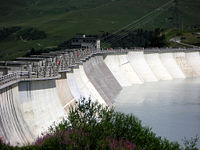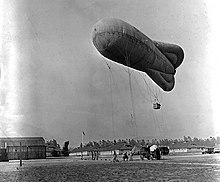|
Albert Caquot
Albert Irénée Caquot (French pronunciation: [albɛʁ iʁene kako]; 1 July 1881 – 28 November 1976) was a French engineer. He received the “Croix de Guerre 1914–1918 (France)” (military honor) and was Grand-croix of the Légion d’Honneur (1951). In 1962, he was awarded the Wilhelm Exner Medal.[1] He was a member of the French Academy of Sciences from 1934 until his death in 1976. Early lifeAlbert was born to Paul Auguste Ondrine Caquot and his wife, Marie Irma (nee Cousinard).[2] They owned a family farm in Vouziers, in the Ardennes, near the Belgian border. His father taught him modernism, by installing electricity and telephone as early as 1890. One year after high school, at eighteen years old, he was admitted at the Ecole Polytechnique[2] ("year" 1899). Six years later, he graduated in the Corps des Ponts et Chaussées. CareerFrom 1905 to 1912, he was a project manager in Troyes (Aube) and was pointed out for civil work improvements he undertook with the city sewer system. This protected the city from the centennial flood of the River Seine in 1910. In 1912, he joined a leading structural engineering firm where he applied his unique talent as a structure designer. Albert Caquot conducted research and immediately applied it in construction. His most notable contributions include the following:
 In the course of his life, Albert Caquot taught mechanical science for a long time in three of the most prominent French engineering schools in Paris: Écoles nationales supérieures des Mines, des Ponts et de l’Aéronautique. In the course of his career as a designer, he designed more than 300 bridges and facilities, among which several were world records at the time:

 Two prestigious achievements made him famous internationally: the internal structure of the Christ the Redeemer statue in Rio de Janeiro (Brazil) at the peak of Corcovado Mountain (1931)[3] and the George V Bridge on the Clyde River in Glasgow (Scotland) for which the Scottish engineers asked for his assistance. In his late eighties, he developed a gigantic tidal power project to capture the tide energy in Mont St Michel bay, in Normandy. AeronauticsDuring the course of his life, he committed alternately to structural and aeronautical engineering, following the rhythm imposed by the First and Second World Wars. Albert Caquot's aeronautics contributions included designing the "Caquot dirigible"[4] and technical innovations at the new French Aviation Ministry, where he created several Fluid Mechanics Institutes that still exist today. Marcel Dassault, whom Albert Caquot charged to develop several major aeronautical projects at the beginning of his career, and mentioned that he was one of the best engineers that aeronautics ever had. He (Albert Caquot) was visionary and ahead of his time. He led aeronautical innovations for forty years. As early as 1901, already visionary, he performed his military service in an airship unit of the French army. At the beginning of First World War, he was mobilised with the 40e Compagnie d'Aérostiers equipped with Drachen type airships as first lieutenant. He noticed the poor wind behavior of these sausage shaped captive balloons, which were ineffective except in calm conditions.   In 1914, he designed a new sausage-shaped dirigible equipped with three air-filled lobes spaced evenly around the tail as stabilizers. He moved the inner air balloonette from the rear to the underside of the nose, separate from the main gas envelope. The Caquot could hold in 90 km/h winds and remain horizontal. France manufactured "Caquot dirigibles" for all the allied forces, including the English and United States armies, for three years. The United States also manufactured nearly a thousand "Caquot R balloons" in 1918-1919. This balloon gave France and its allies an advantage in military observation, significantly contributing to the allies' supremacy in artillery and aviation and eventually to the final victory. In January 1918, Georges Clémenceau named him technical director of the entire military aviation. In 1919, Albert Caquot proposed the creation of the French aeronautical museum (today called Musée de l'Air et de l'Espace, in Le Bourget). This museum is the oldest aeronautical museum in the world. In 1928, Albert Caquot became the first executive director of the new Aviation ministry. He implemented a research, prototypes, and mass production policy, which contributed quickly to France's leadership in the aeronautical industry. His main accomplishments are:
In 1933, after a budget cut prevented him from proceeding with his projects, he resigned and returned to structural engineering for several years. In 1938, under the threat of the war, Albert Caquot was brought back to manage all the national aeronautical businesses. He resigned in January 1940. LegacyOn 2 July 2001, a 4.5-FRF (0.69-€) stamp was issued in France to celebrate Albert Caquot's legacy on the 120th anniversary of his birth and the 25th anniversary of his death. A “Caquot dirigeable" and the bridge of La Caille, two of his creations, surround his picture on the stamp. Since 1989, the Prix Albert Caquot is awarded annually by the French Association of Civil and Structural Engineering. See also
Notes
Bibliography
External linksWikimedia Commons has media related to Albert Caquot.
|
||||||||||||||||||||
